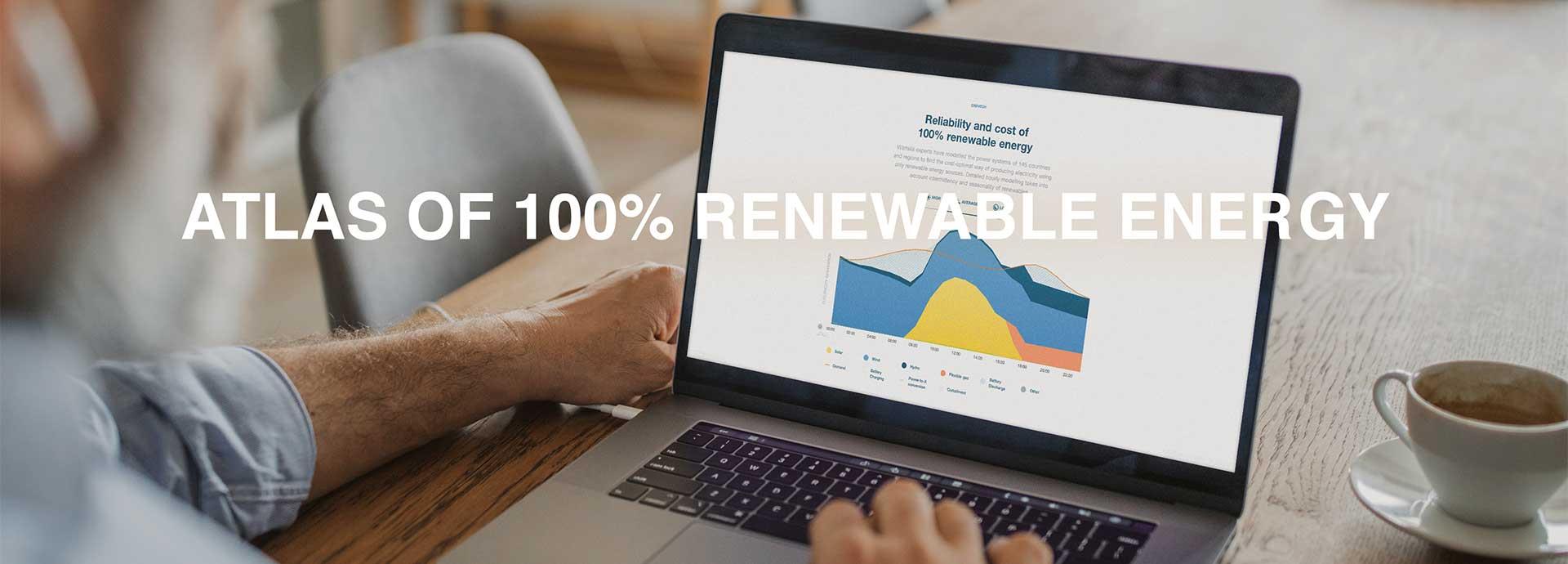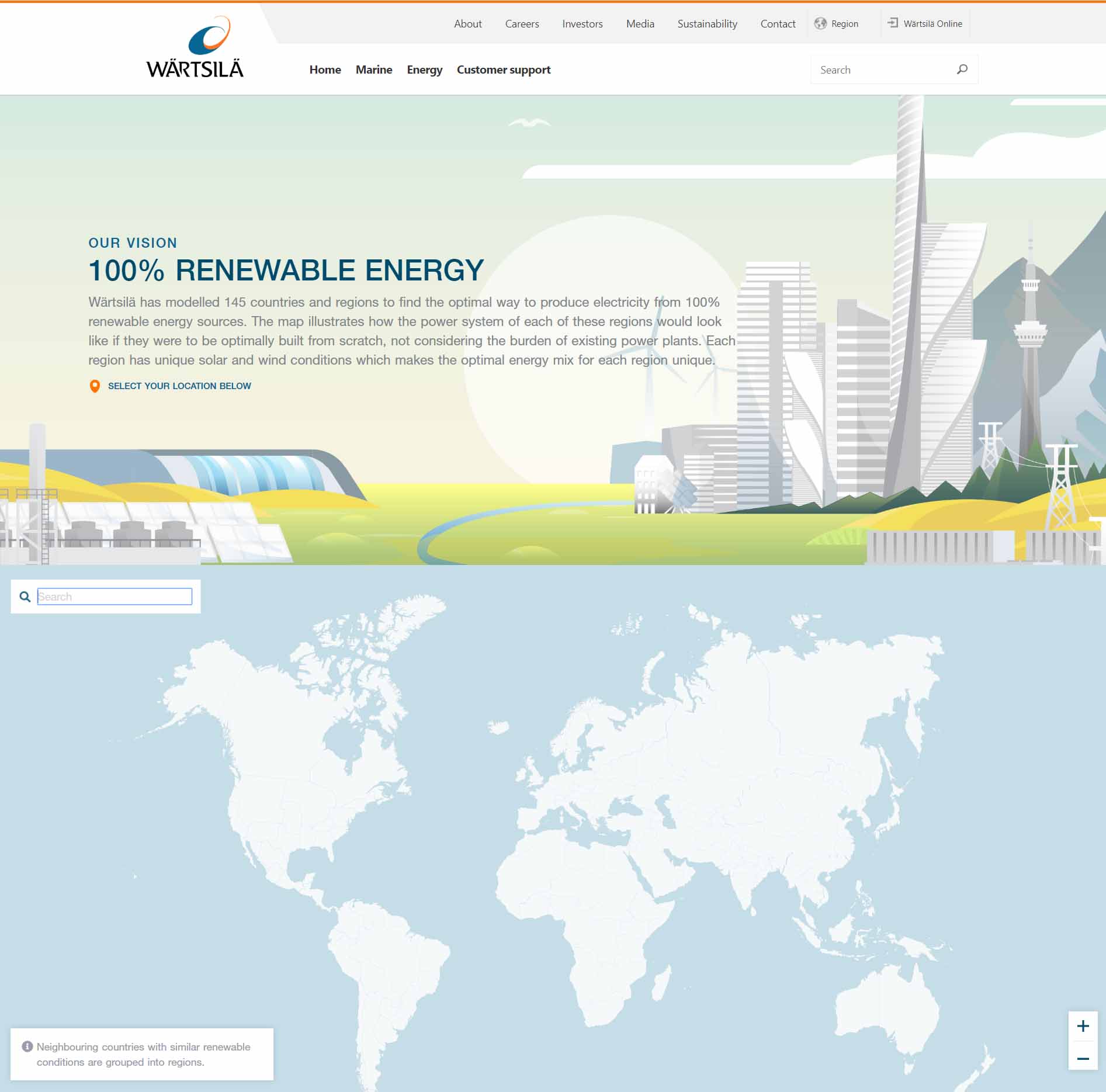

Wärtsilä has published a new interactive map – the Atlas of 100% Renewable Energy – that showcases the potential of cost-optimal 100% renewable electricity systems across the globe.
After having faced an uphill battle for years, being considered too expensive or unreliable for a global scale-up, renewable energy sources are gaining momentum. Today, they are an economically rational option, but also a par excellence energy choice
for a growing number of players stepping up their sustainability effort in a bid to fight climate change.
Since electricity generation and heating account for 25% of global greenhouse gases, shifting towards 100% renewable energy
systems will be key in dealing with the climate crisis. Wärtsilä has modelled 145 countries and regions, globally, to show the cost-optimal 100% renewable energy systems in one interactive map that serves as an illustrative guide.
“With this map, we are showing how renewable energy conditions drive the way any power system should be designed. The rest of the system should be there to support the renewables, not vice versa,” says Antti Räty, Power System Analyst for Wärtsilä Energy Business, a member of the team behind the modelling for the map.
The modelling work relies on the Lappeenranta-Lahti University of Technology (LUT) database
of power systems data of different countries and regions across the world. Using detailed modelling, Wärtsilä’s team was able to find the cost-optimal energy mix for a 100% renewable energy system in all of the regions with unique
conditions for renewable energy. The modelling also shows what kind of flexibility, short term and long term, is needed to support renewable energy in each case. The modelling approach was to build the energy systems from a fresh start: only hydro-power
and geothermal were included from today's power plants.

"With this map, we are showing how renewable energy conditions drive the way any power system should be designed," says Antti Räty, Power System Analyst for Wärtsilä Energy Business.
Different ways to achieve 100%
While pivoting towards 100% renewable energy is possible in every country or region featured on the map, the best way to take advantage of cheap renewable resources can be quite different depending on where you are.
“For countries
near the Equator, solar conditions will be stable throughout the year. Further North or South, seasonality of the solar intensity gets higher, but you might opt for more wind,” says Räty. “For instance, in southern Nigeria, the fully
renewable power system would be mainly based on solar energy, complemented with a significant amount of battery storage to shift solar energy from daytime until night and flexible gas generation running on carbon-neutral synthetic fuels to handle
longer periods of low solar power availability. On the British Isles, on the other hand, the energy mix will be based more on wind energy. Batteries are not such a natural pairing with wind power, but the flexible gas generation with renewable synthetic
fuels can push power systems even through long periods of low wind,” he explains.
A vital part of the cost-optimal 100% renewable energy systems is the ability to provide long term flexibility to cover seasonal variations or
longer slumps in renewable energy output. This is what flexible gas, synthetic fuels and Power-to-X are all about. ‘Power-to-X’ is an umbrella term for different solutions which use surplus renewable energy to create other products. Renewable
energy can be used to convert hydrogen from water and carbon dioxide from the air into carbon-neutral synthetic fuels. These carbon neutral fuels can be stored for long periods and used when needed, providing much-needed reliability to power systems
fully based on renewable energy.
Wärtsilä’s modelling presents the option of allowing all these technologies into the capacity mix, as well as an alternative scenario where only wind, solar and battery energy
storage can be added to the system. The differences in capacity needs and system costs highlight why flexible generation is an important part of power systems reaching for 100% renewable energy.
“A lot of countries and utilities
are starting to set their eyes on 100% renewable energy. Some aim to get there by investing only into wind, solar and battery storage. Through modelling we want to highlight why adding flexibility into the system actually allows us to make the most
of renewables, and that this flexible generation will be part of the systems even when they are 100% renewable,” explains Räty.
Not ‘if’ but ‘when’
Based on such power system modelling, Wärtsilä can provide tailor-made sustainable solutions for any location, believes Saara Kujala, General Manager of Business Development with Wärtsilä Energy Business.
“This map is a great conversation starter to get our stakeholders and clients - both private and public players - to think about future possibilities. The trend towards high renewable power systems is visible both in electricity
market - based systems, such as in much of Europe and the US, where the private utilities are diversifying their portfolios, as well as in countries where single-buyer utilities implement long-term development plans, for example in many parts of Asia”
she says.
“With our stakeholders and clients, we can together come up with solutions that will take into account what type of assets [they] should be investing in, and when,” Kujala adds.
Kujala says that
renewable energy systems used to be considered “a different kind of animal”, unreliable and difficult to operate. But today different storage and energy conversion solutions are becoming more mainstream, and the overall reliability of
the systems has increased. Moreover, there is an important financial incentive to switch to renewables as they have become the cheapest energy source even without subsidies.
Even if the initial price tag for energy infrastructure might be high, the costs will eventually flatten out. “It is very important to have
a system-level view of the transition cost. We don’t want to compare the cost of wind against solar or the cost of battery storage against renewable synthetic fuels but check how they might contribute to the total cost of the system,”
Kujala says. She is confident that people have accepted that 100% renewable energy systems are the future. “The question is not if we are heading where, but when - in the next ten, twenty or 50 years,” she says.
Did you like this? Subscribe to Insights updates!
Once every six weeks, you will get the top picks – the latest and the greatest pieces – from this Insights channel by email.